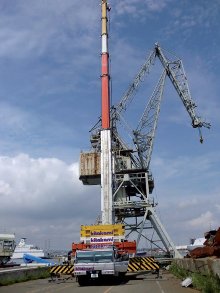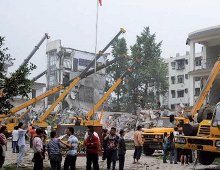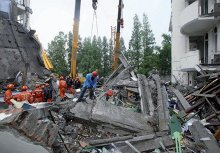After the flood
15 November 2012In the second part of a two-part series on the impact of disasters in the Pacific region, Stuart Anderson looks at earthquakes, tsunamis and floods in Asia.
The Great East Japan Earthquake and Tsunami that struck the northeastern provinces of Japan on March 11th, 2011 took the lives of an estimated 20,000 citizens. T As tragic as this enormous disaster was, it was the subsequent Fukushima nuclear power plant accident and its implications that have continued to claim headlines worldwide.
The area affected by the earth quake and tsunami is huge. In the 18 months since, repair and remedial work has focused on the tens of thousands of business and residential buildings damaged or destroyed. In the meantime, Japanese public anguish has been further heightened by a new Government study suggesting that in a worst case scenario up to 320,000 could perish if three earthquakes occur simultaneously along the Nankai Trough, with 70% of the victims drowning by the subsequent tsunami.
Meanwhile counter-measures for enhanced protection of existing nuclear facilities are just beginning. Clearly, nuclear power plants located in elevated areas such as on hillsides do not face the risk of the flooding that hit Fukushima as the tsunami swept through. Amongst the most critical lessons learned from the Great East Japan Earthquake was the need for back-up power generators and rapid evacuation. One study suggests that if evacuation started within 10 minutes of a quake, deaths could be reduced by 80%.
Many businesses are urgently taking steps to minimize future risk with the purchase of their own generators. Typical of the pro-active nature of Japan's citizenry and businesses, air conditioners are being turned down or completely off to save electricity during the height of the summer. Indeed, during my recent visit to Tadano's headquarters plant in Takamatsu City, the temperature settings in the offices had been increased to conserve power. Toyota is planning to build breakwaters at its plant in Tahara, Aichi prefecture where Lexus cars are built. West Japan Railway Company will invest ¥57bn ($730m) over the next 10 years including anti-seismic retrofitting of elevated bridges for its Shinkansen (bullet train) line. Showa Shell will install back-up power at its shipping terminal tanks and solar power at 450 of its gas stations. Other manufacturers along the Nankai Trough potential 'megaquake' fault line, such as Suzuki Motor, are planning to completely relocate production facilities.
Meanwhile the government will invest ¥35.4bn ($450m) for disaster management measures including establishing core gas stations with large underground tanks at about 50 sites in each prefecture to secure gasoline for medical organizations, evacuation sites and emergency vehicles. Nuclear plants in threatened locations will either be relocated or shut-down. Still the fears of nuclear contamination proliferate. In the region around Fukushima quarried building materials were found to have been contaminated and several building projects were put on hold. Not surprisingly, most efforts to calm public fears fall on deaf ears.
To supplement the existing equipment fleets of local contractors and renters, Japan's big nationwide equipment rental companies such as Aktio and Nikken relocated large fleets of earthmoving, transportation and lifting equipment. To date most of the local crane work has been within the capabilities of local crane rental companies and contractors. Most of the lifting work has involved 25 and 50- tonne capacity RTs as well as mini tele boom crawler cranes and truck loader cranes.
T Takahashi, general manager, domestic sales, Tadano confirmed that the manufacturer's domestic demand has been boosted by reconstruction work in the North-Eastern part of Japan affected by the Great East Earthquake and Tsunami and Fukushima nuclear power plant disaster: "Mobile crane utilization has increased in the affected area to the extent that the region now accounts for 12-13% of total domestic demand versus 8% prior to the disaster." However, he speculates that crane utilization could be significantly higher if it were not for restraining influence of Japan's chronic shortage of crane operators. "Crane rental rates for a 25t rough terrain (in reality similar in performance to a 35USt RT) have increased in the affected region to ¥45-50,000 ($550-625,000) per day compared to the nationwide average of ¥30-40,000 ($375-500), but so far this has not resulted in increased availability of crane operators." To date most of the work has been in the private sector. The next phase will be public sector remedial work to the core infrastructure and will ratchet up demand for larger all terrains and crawlers.
The issue of those cranes that were polluted during the Fukushima nuclear plant accident is on-going. Some twenty cranes were either on-site at the plant or in the immediate vicinity and remain in quarantine. Takahashi says, "Most are 25 or 50t RTs but three large Tadano ATs are radioactive and quarantined -- two 200t (220USt) AR 2000Ms and one 550t (600USt) capacity AR 5500M. Unfortunately most of the local crane owners did not operate with insurance policies sufficiently robust to cover this type of devastating accident. They have lost the use of their cranes and to date have not been compensated."
It is recognized that the cost of detoxing the severely affected radio-active cranes is economically unviable. Firstly all of the non-metallic parts would have to be trashed - everything from the rubber tyres and hydraulic hoses, sheaves, seats, nylatron sheaves and all plastics in the cab interiors, controllers, etc. are automatic write-offs. Even if 'cleaning' the steel structures were economically viable, this would only be for the use of larger structures as second-hand replacement parts. Clearly the cost of totally dismembering the rest of the crane piece by piece and replacing virtually all parts at spare parts costs makes any idea of rebuilding the cranes an absolute non-starter.
As we have seen in the reports of all of Japan's crane (and earthmoving machinery) manufacturers, the enormous clean-up and rebuilding or repair effort has dramatically boosted demand for new machines and is likely to have an influence upon domestic demand for several years to come. Of the 1,075,195 buildings estimated to have been affected by the Japanese government some 383,430 were either totally or largely destroyed.
Kobelco Cranes' experience was typical of the crawler crane sector. In the first half of fiscal 2011, ended Sept 30th, sales declined year-on-year by 1.6%, partly due to the disruption of supply chains and production resulting from the earthquake and Tsunami. Even so, the manufacturer recognized the beginnings of reconstruction work at ports and in the general infrastructure. By the end of Fiscal 2011, at the end of March 2012, revenues for the year were up 17.2% to ¥48,005m ($601.26m) with "reconstruction demand in Japan helping to increase sales of new crane models".
Tadano had expressed similar sentiments as the manufacturer reported worldwide sales of all products up 27.2% to ¥114,209m ($1,430.5 million) in fiscal 2011 ended March 30th 2012. While the high value of the Japanese Yen made exports challenging, domestic sales for all products rose 19% to Y61,337 million ($768.2 million). Tadano explained that "During fiscal year 2011, the Japanese economy recovered from the sudden downturn caused by last year's Great East Japan Earthquake. Earthquake recovery efforts have driven domestic demand since the start of the year. Domestic production in the crane industry recovered, following a temporary drop caused by supply line disruptions attributable to the earthquake. Increasing utilisation rates related to earthquake recovery and restoration efforts boosted scheduled equipment replacement, increasing domestic demand significantly."
Domestic sales of Tadano mobile cranes (primarily RTs) increased 21.5% to ¥24,146m ($302.4m) while total sales of truck-loader cranes, 90% of which are sold domestically, increased by an impressive 42.2% to ¥10,166m ($127.3m) "backed by rising truck demand generated by earthquake-related demand".
For the current fiscal year to March 30th 2013, Tadano is forecasting a further increase of 15.6% to total revenues of ¥132,000m ($1,650m). The company says "we expect the Japanese economy to experience a solid recovery driven by various factors, including domestic demand in the first half of the financial year backed by public investment, capital investment and residential development, all related to full-fledged earthquake recovery efforts."
Cargotec Japan's vice president Toshiya Suzuki expects the earthquake clean-up work to continue. "Looking ahead, there will be an increased demand for our cranes in the scrapping business over the next 2 to 3 years for the (earthquake) recovery process. By then, we need to build on our existing strong and stable business field including in forestry, and in the upcoming field of biomass." Forestry market demand for knuckle boom loaders is also expected to increase thanks to the Japanese Government's subsidization of the domestic forestry industry, aimed at increasing the nation's self-sufficiency in timber to 50% over the decade to 2018.
A non-nuclear future?
On September 14th the Japanese government announced that the panel it had established to develop a new energy plan for the country had proposed to completely phase-out nuclear power by 2040. Japan depended upon its 54 nuclear plants to generate some 30% of its energy needs and had planned to increase this to 50% by 2030 with the construction of an additional 14 power plants. Japan's nuclear plants were built between the early 1970s and 2006 and under the new proposal all would be shut down when they reach an operating life of 40 years and no new plants would be built. The policy document stated, "Every policy resource will be brought to bear to make it possible to have zero nuclear power plants in operation by the 2030s."
The proposals of the 'expert' panel assembled by Japan's ruling LDP Party came after several months of
deliberations, but if anything seems to have done little to clarify the issue but rather fan the flames. The panel based its findings upon a deliberative opinion poll as well as 90,000 comments and opinions, plus 1,300 responses to questionnaires and opinions from industry groups. The opinion poll asked participants to vote for a Japan in 2030 with either zero percent nuclear energy, or 15% nuclear energy or 20-25% nuclear. While public comments and hearings featured respectively 87% and 67.9% voting for the 'zero' option, it was felt that this reflected the views of groups or individuals with strong views rather than general opinion. The deliberative opinion poll suggested that less than 52% desired the 'zero' option and that some 38% favored 20-25% or some other approach. Critically, the polls avoided addressing the other side of the debate -- if not nuclear then what and at what cost?
Within days of the announcement of the panel's plan, on September 19th, the Japanese government stopped short of approving the proposal that would see the nuclear phase-out by 2040. Lawmakers only partially-endorsed the report and removed any mention of the deadline. Deputy Prime Minister Katsuya Okada said, "We aim to have zero nuclear power by the 2030s but we have never said we will achieve zero by that date." Japan's pro-nuclear lobby, nicknamed "Genpatsu mura" (atomic village), argues along with business leaders that the phase-out isn't economically feasible and would force manufacturing production to be relocated overseas.
Inflamng public opinion further within days of the panel's proposals for a non-nuclear future, the government confirmed its intention to continue the construction of two new nuclear power plants in Aomori, Northern Japan and a third in the Western district of Shimane, arguing that these had already been planned and approved prior to the Fukushima accident. Japan's rural prefectures are the strongest opponents to nuclear power and the governor of Niigata has already warned that he would not necessarily agree to the restart of local reactors.
Japan's energy future
The pronouncement by the Japanese 'panel of experts' follows last year's decision by Angela Merkel to shut-down half of Germany's nuclear plants and to phase-out the remainder and replace them with renewables over the next decade.
While Japan's timetable is far less ambitious than that of Germany it has been seriously questioned by officials in the US, UK and France. In some parts of Japan, local government officials have blocked the restart of nuclear reactors closed for safety inspections, drawing further concern from domestic business groups. When Prime Minister Noda had two decommissioned reactors at the Ohi nuclear plant in Western Japan restarted, 100,000 people took to the streets of Tokyo to protest.
Japan's decision, if fully followed through, has massive international implications. As the world's third largest nuclear power generator, it will reinforce anti-nuclear movements around the world, reignite debate and cause many governments whose nuclear expansion plans already 'paused', to think again. The plan will mean lower demand for uranium and increased long-term demand for commodities such as crude oil, LNG and thermal coal. Japan is by far the largest buyer of liquefied natural gas and along with China, the world's largest importer of thermal coal. The move is also expected to result in Japan's trading companies - the sogo shosha - to redouble their investments in commodities production around the world.
A Japanese Environment Ministry draft report proposes that by 2030 renewables might substitute 20 nuclear plants that today provide 19.4kW or 10% of the nation's energy compared with just 1% of national power presently generated by renewable (excluding hydro-electric power). Although general public perceptions of the role that renewables can play in any short-tomedium term sense remain vastly over-optimistic, Government and Industry leaders recognize the limitations of renewables. Under the new proposal, offshore wind power would be the big winner- increasing from a mere 30,000 kW to 8.03 million kW. Geothermal power would dramatically increase from 530,000kW to 3.88kW. After the US and Indonesia, Japan, the land of volcanoes and hot springs, has the world's largest geothermal potential and the government plans to open more national parks in Northern Japan to geothermal development.
Japan would also make big investments in marine (wave) energy that would go from 0 today to 1.5m kW by 2030 while biomass would more than double its contribution from 2.4 to 6m kW. On July 1st, a new law came into effect requiring Japan's nine regional electricity monopolies to buy energy produced using renewable sources at comparatively high prices from private producers and feed it into their grids.
The prefecture around Fukushima already officially denounced nuclear and a consortium is planning to build the world's largest wind farm offshore, which, because of the depth of the ocean, will involve the turbines being installed on floating platforms.
The potential economic implications of a move away from nuclear are already emerging. In 2011 Japan's balance of trade slipped into the red for the first time in 31 years. Oil and gas imports substituted nuclear power as the generating load on conventional power plants increased. Next on the agenda is the effect Japan's target of reducing greenhouse gas emissions 20% from 1990 levels and cutting energy consumption 10% from 2010. There are no easy options!
Flooded again
When it comes to floods, lightening really does strike twice. Early September saw the dykes in Thailand's Sukhothai region breeched by the rain-swollen Yom Rive, submerging large tracts of the former Royal Capital some 400km (250mi) north of Bangkok. While relatively minor compared to last year's worst-ever floods, they illustrated to failure of the Governments plans to win the race to shore up flood defences prior to the current season. They also arrived just two weeks after Thailand's ruling Yingluck administration announced a new and far-reaching $11.5bn flood defence plan.
The plan is absolutely critical to Thailand's economic future. In the fourth quarter of last year, in the wake of last year's floods that closed thousands of factories including the auto plants of Honda and Suzuki, Thailand's economy contracted by 9-10%. The Chao Phraya river's basin drains in Bangkok but covers 30% of the nation's land area in which 78% of total GDP is generated.
Provided it acts to develop effective protection to floods, Thailand's future remains potentially very bright as it seeks to expand its already large industrial manufacturing base. Indeed Tadano recently acquired land to build a new truck-loader plant close to that already operated by competitor, Furukawa-Unic. The government has also announced an $80bn 10-year infrastructure plan with up to 50% spent on the railway network. Last year imports of new mobile cranes tripled to approximately 70 units. The vast majority were small-to-medium size Chinese truck cranes but sales of rough terrains also doubled.
Like New Orleans, cities like Bangkok, Dhaka, Ho Chi Minh City and Tianjin were built on the deltas of major rivers. They are at high risk of both inland and coastal flooding.
In August, the Manila-based Asian Development Bank (AsDB) warned "Rising urban populations mean that over 400 million people in Asian cities may be at risk of coastal flooding and approximately 350 million at risk of inland flooding by 2015. Unless managed properly these trends could lead to widespread environmental degradation and declining living standards." For many low-lying nations to continue their economic growth, massive and urgent investments in flood defence will need to be made.


